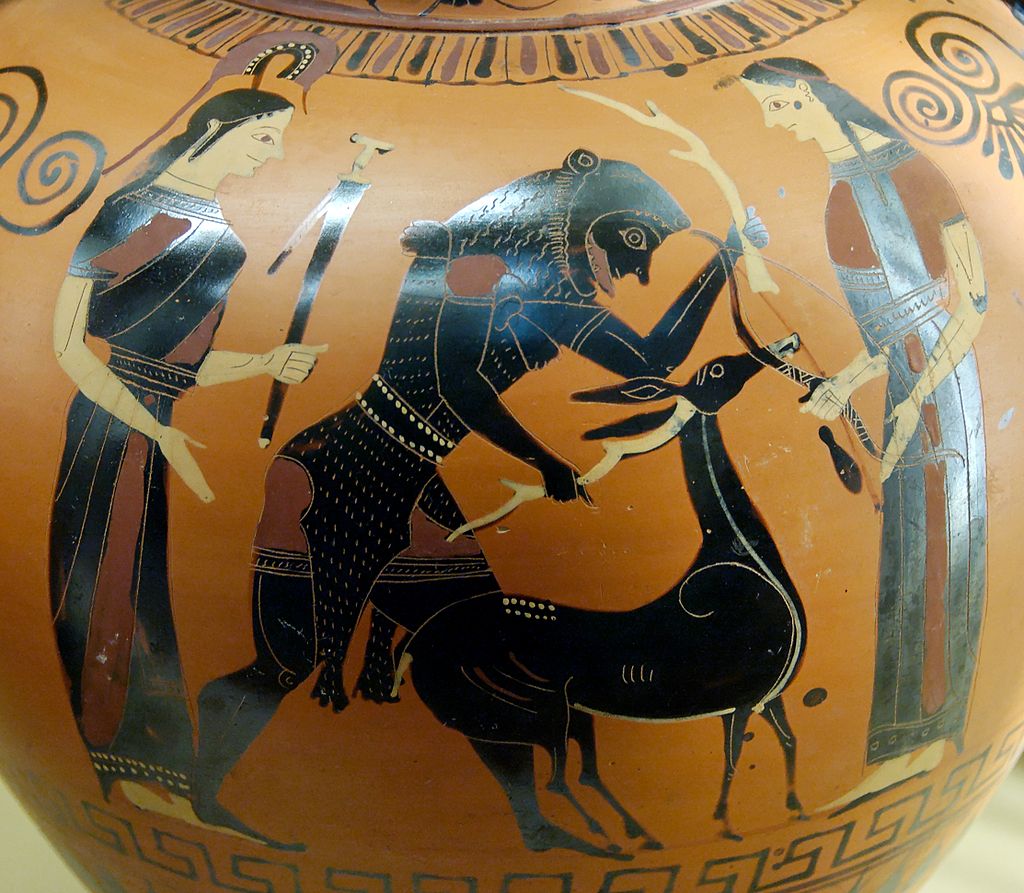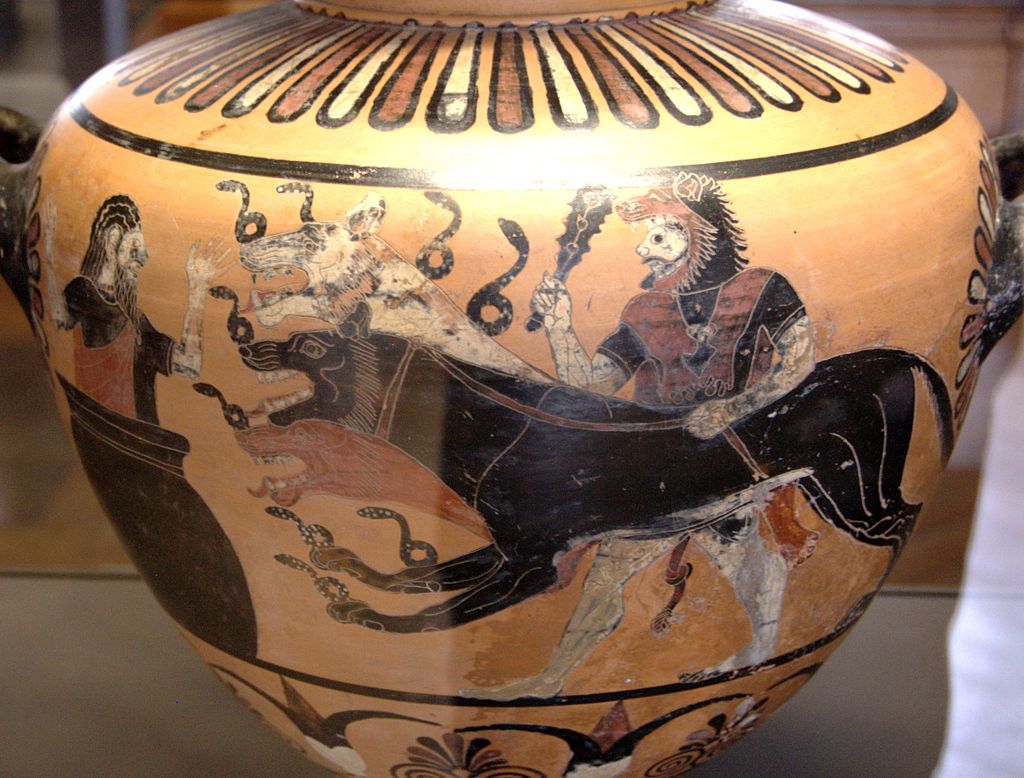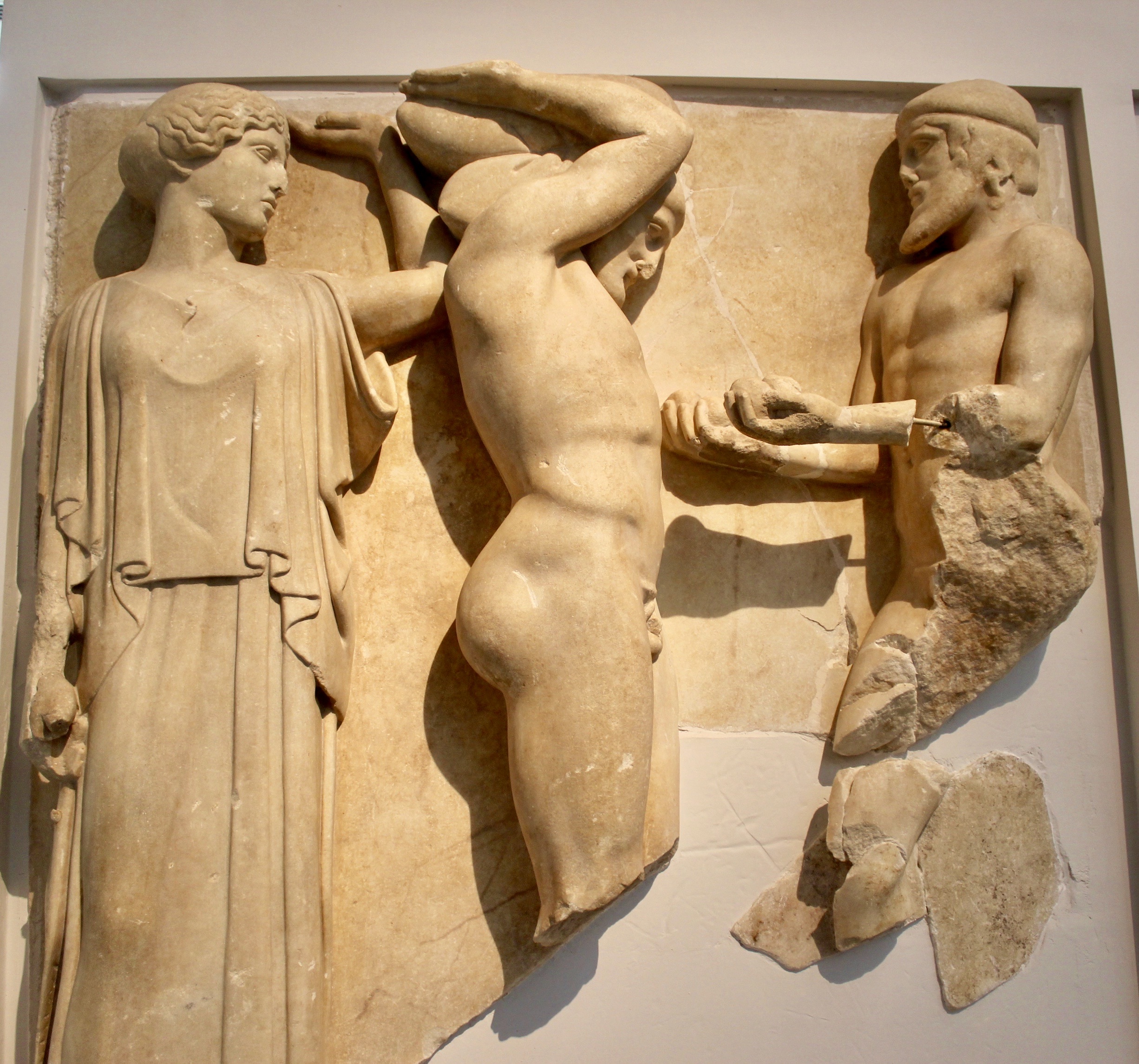We have been enjoying Gregory Nagy’s series of posts on Hēraklēs at Classical Inquiries[1]. The Hēraklēs myths have inspired many artworks from classical times onward: he is probably the most represented of all the ancient Greek heroes. So we have prepared two galleries with a selection. This first includes depictions of the Labors of Hēraklēs.
In The Ancient Greek Hero in 24 Hours Gregory Nagy provides the background to the story of Hēraklēs as outlined by Diodorus:
The supreme god and king of gods, Zeus, impregnates Alkmene, a mortal woman (4.9.2). The wife of Zeus, the goddess Hērā, is jealous; she decides to intervene in the life of the hero who is about to be born, Hēraklēs (4.9.4). If this hero had been born on schedule, on time, in time, he would have been the supreme king of his time; but Hērā makes sure that Hēraklēs is born not on schedule, not on time, not in time. Hēraklēs’ inferior cousin, Eurystheus, is born ahead of him and thus is fated to become king instead of Hēraklēs (4.9.4-5). During all of Hēraklēs’ lifetime, Eurystheus persecutes him directly; Hērā persecutes him indirectly. The superior hero has to spend his entire lifespan obeying the orders of the inferior king (4.9.5). Hēraklēs follows up on each one of the orders, and his accomplishments in the process add up to the Labors of Hēraklēs.”[2]
The twelve canonical Labors he lists as follows:
- Hēraklēs kills the Nemean Lion (4.11.3-4)
- Hēraklēs kills the Lernaean Hydra (4.11.5-6)
- Hēraklēs kills the Erymanthian Boar (4.12.1-2)
- Hēraklēs hunts down the Hind with the Golden Horn (4.13.1)
- Hēraklēs clears the Stymphalian Marsh of the noxious birds that infested it (4.13.2)
- Hēraklēs clears the manure from the Augean Stables (4.13.3)
- Hēraklēs captures the Cretan Bull alive and brings it to the Peloponnesus (4.13.4)
- Hēraklēs corrals the Horses of Diomedes, eaters of human flesh (4.15.3-4)
- Hēraklēs captures the waistband or ‘girdle’ of the Amazon Hippolyte (4.16.1-4)
- Hēraklēs rustles the Cattle of Geryon (4.17.1-2)
- Hēraklēs descends to Hādēs and brings up Cerberus the Hound of Hādēs from the zone of darkness to the zone of light and life (4.26.1)
- Hēraklēs gathers the Golden Apples of the Hesperides (4.26.2-4).
(H24H 1§43)
In the post 2019.08.15 “Thinking comparatively about Greek mythology IV, Reconstructing Hēraklēs backward in time” Gregory Nagy discusses these Labors [āthloi] and additional sub-labors or deeds, and an alternative sequence, and analyses the way the main Labors derive from an “Indo-European” mythological tradition[3].
The main Labors have always been a popular subject for visual representation. We’ve selected just a few for this Gallery.
We invite members to share in the forum further images depicting the Twelve Labors.
Gallery | Hēraklēs, part 2: Other depictions of Hēraklēs
Notes
[1] Classical Inquiries
https://classical-inquiries.chs.harvard.edu/
[2] Nagy, Gregory. 2013. The Ancient Greek Hero in 24 Hours, 1§42. Harvard University Press, Cambridge, MA: 2013. Available online at CHS.
https://nrs.harvard.edu/urn-3:hul.ebook:CHS_NagyG.The_Ancient_Greek_Hero_in_24_Hours.2013
[3] https://classical-inquiries.chs.harvard.edu/thinking-comparatively-about-greek-mythology-iv-reconstructing-herakles-backward-in-time/
Image credits
FEATURED IMAGE
Mosaic, Labors of Hercules, 3rd century CE, National Archaeological Museum of Spain.
Photo: Carole Raddato, Creative Commons Attribution-Share Alike 2.0 Generic license, via Wikimedia Commons
NEMEAN LION
Hercules fighting the Nemean Lion. Detail of the Twelve Labours Roman mosaic, Valencia, Spain. 201–250 CE.
Photo: Luis García. Creative Commons Attribution-Share Alike 3.0 Unported license, via Wikimedia Commons.
Pieter Paul Rubens *1577–1640): Heracles and the Nemean Lion. National Museum of Art of Romania.
Photo: Yelkrokoyade. Public domain, via Wikimedia Commons
HYDRA
Antonio del Pollaiolo: Hercules and the Hydra. c. 1475. Uffizi Gallery.
Public domain, via Wikimedia Commons.
ERYMANTHIAN BOAR
Antimenes Painter. Herakles, Eurystheus and the Erymanthian Boar. Side A black-figured amphora c 525 BCE. Louvre.
Photo: Bibi Saint-Pol. Public domain, via Wikimedia Commons.
Hercules capturing the Erymanthian Boar. Marble relief, end of 3rd century CE. Musée Saint-Raymond, Toulouse.
Photo: Carole Raddato. Creative Commons Attribution-Share Alike 2.0 Generic license. via Wikimedia Commons.
Louis Tuaillon Sculpture Herkules und der erymantische Eber. 1904.
Photo: OTFW. Creative Commons Attribution-Share Alike 3.0 Unported, 2.5 Generic, 2.0 Generic and 1.0 Generic license. via Wikimedia Commons.
HIND WITH THE GOLDEN HORN
Herakles captures the Hind of Keryneia. Attic black-figured neck-amphora. c 540–530 BCE. British Museum.
Photo: Jastrow. Public domain, via Wikimedia Commons
Adolf Schmidt (1804–1865): Herkules besiegt die goldbekrönte Hirschkuh
Photo: ONAR. Creative Commons Attribution-Share Alike 3.0 Unported license. via Wikimedia Commons.
STYMPHALIAN MARSH AND THE BIRDS
Heracles killing the Symphalian birds with his sling. Attic black-figured amphora c 540 BCE. British Museum.
Photo: Jastrow. Public domain via Wikimedia Commons.
Vittore Gambello. Seated Hercules in the Act of Shooting at the Stymphalian Birds. c 1515–1520. Metropolitan Museum of Art.
Creative Commons CC0 1.0 Universal Public Domain Dedication. via Wikimedia Commons
AUGEAN STABLES
Hercules cleaning the Augean Stables. Relief from Villa Chiragain, Musée Saint-Raymond, Toulouse. End of 3rd century CE.
Photo: Caroline Léna Becker. Creative Commons Attribution 3.0 Unported license. via Wikimedia Commons
HORSES OF DIOMEDES
Jean Baptiste Marie Pierre: Diomedes King of Thrace Killed by Hercules and Devoured by His Own Horses. 1752. Fabre Museum.
Public domain, via Wikimedia Commons
GIRDLE OF HIPPOLYTE
Attributed to the Medea Group: Herakles fighting Amazons. Side A Attic black-figure amphora, c 520 BCE. Metropolitan Museum of Art
Photo: Marie-Lan Nguyen. Creative Commons Attribution 2.5 Generic license. via Wikimedia Commons
Nicolaes Knüpfer: Hercules Obtaining the Girdle of Hyppolita. first half of 17th century.
Public domain, via Wikimedia Commons
CATTLE OF GERYON
E Group: Herakles fighting Geryon. Side A, Attic black-figure amphora. Louvre.
Photo: Marie-Lan Nguyen. Public domain, via Wikimedia Commons.
Giulio Bonasone: Hercules driving off the cattle of Geryon, at the right the nymphs of Hesperides. 1531–1576. Metropolitan Museum of Art. Public domain.
CERBERUS
Eagle Painter: Herakles, Cerberus and Eurystheus. Side A, hydria, c 525 BCE. Louvre.
Photo: Bibi Saint-Pol. Public domain, via Wikimedia Commons
GOLDEN APPLES OF HESPERIDES
Herakles holding up the sky with Athena’s help, Atlas offering the apples. Metope from Olympia.
Photo: Kosmos Society.
Etruscan gem: Herakles with the Apples of the Hesperides, 5th century BCE. Walters Art Museum, public domain, via Wikimedia Commons.
TWELVE LABOURS
Front panel of sarcophagus. Roman, mid 3rd century CE. Museo nazionale romano di palazzo Altemps
Photo: Marie-Lan Nguyen. Public domain, via Wikimedia Commons
Note: Images have been selected from pictures that are freely available with open source or Creative Commons licenses or from photographs sent in by community members for the purpose. The images in this post are intended to suggest the subject, rather than illustrate exactly—as such, they may be from other periods, subjects, or cultures. Attributions are based where possible by those shown by museums, or on Wikimedia Commons, at the time of publication on this website.
Images and online texts accessed December 2019.
First published December 23, 2019
___
Hélène Emeriaud, Janet Ozsolak, and Sarah Scott are members of Kosmos Society.



















